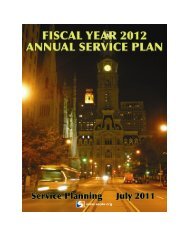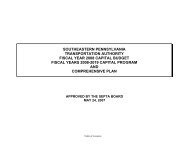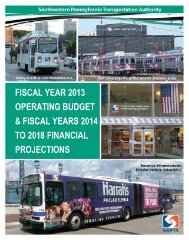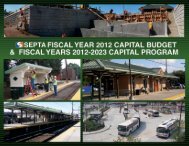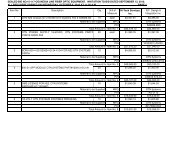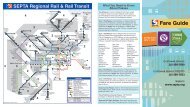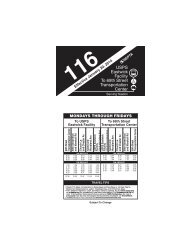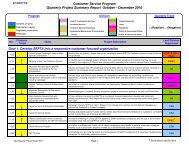FY 2012 Operating Budget and FY 2013-2017 Financial ... - Septa
FY 2012 Operating Budget and FY 2013-2017 Financial ... - Septa
FY 2012 Operating Budget and FY 2013-2017 Financial ... - Septa
Create successful ePaper yourself
Turn your PDF publications into a flip-book with our unique Google optimized e-Paper software.
<strong>Operating</strong> Goals <strong>and</strong> Performance Evaluation Measures<br />
FINANCIAL PERFORMANCE<br />
Fiscal Indicators<br />
Indicators of the fiscal status of a transportation authority are commonly employed<br />
throughout the industry to assess financial position. These indicators are influenced by many<br />
factors, including overall operating subsidy funding, fare policy, route structure, cost recovery<br />
policy, condition of infrastructure, availability of sufficient capital funding, etc.<br />
For Fiscal Year <strong>2012</strong>, the following fiscal measures will be monitored:<br />
<strong>Operating</strong> Cost Per Passenger<br />
The Authority proposes to provide a cost not to exceed $3.68 per unlinked passenger trip.<br />
<strong>Operating</strong> Subsidy Per Passenger<br />
The Authority proposes to provide overall service operating subsidy not to exceed $2.21 per<br />
unlinked passenger trip.<br />
Cost Per Vehicle Mile<br />
The Authority proposes to achieve an average cost for delivery of service not to exceed<br />
$14.34 per vehicle mile.<br />
ROUTE UTILIZATION<br />
Route utilization is a measure of service performance on a route-by-route basis. The<br />
st<strong>and</strong>ards SEPTA has adopted are summarized below.<br />
City Transit Division<br />
To assess utilization, each route is measured for three key criteria:<br />
• Fully allocated cost<br />
• Total passenger revenue (calculated at CTD average fare)<br />
• <strong>Operating</strong> Ratio (passenger revenue divided by fully allocated cost)<br />
SEPTA's “City Transit Division Service St<strong>and</strong>ards <strong>and</strong> Process” contains the details to apply<br />
these st<strong>and</strong>ards first adopted by the SEPTA Board in April 1995 <strong>and</strong> amended in March<br />
2007. If a route performs below 60% of the City Transit Division average route operating<br />
ratio, then corrective actions begin. Fiscal 2010’s financial results were approved for action<br />
in Fiscal Year <strong>2012</strong>. City Transit Division’s average was 34.0% <strong>and</strong> the subst<strong>and</strong>ard<br />
performance mark was 20%.<br />
Suburban Transit Division (Victory <strong>and</strong> Frontier Divisions)<br />
Each route is measured for three important criteria:<br />
• Fully allocated costs<br />
• Total passenger revenue (calculated at the appropriate Victory or Frontier District<br />
average fare)<br />
• <strong>Operating</strong> ratio (passenger revenue divided by fully allocated costs)<br />
SEPTA Fiscal Year <strong>2012</strong> <strong>Operating</strong> <strong>Budget</strong> 149




